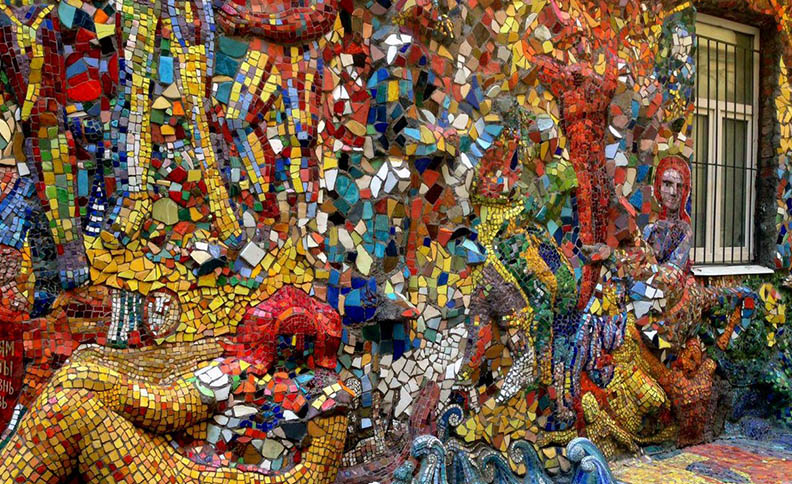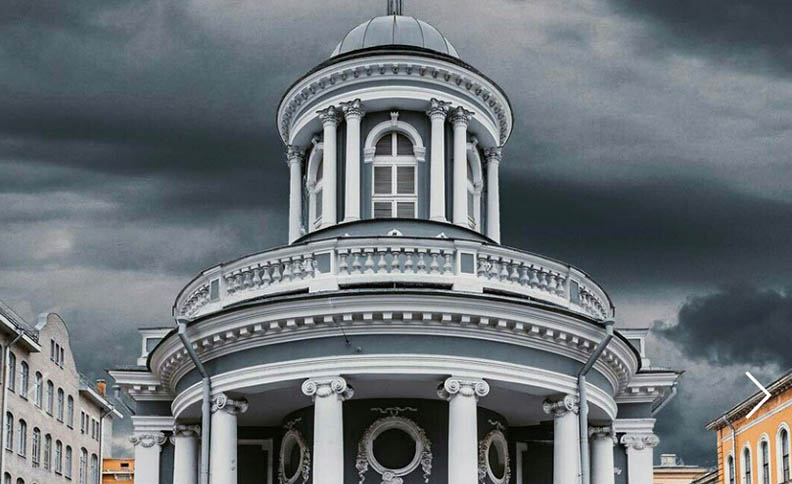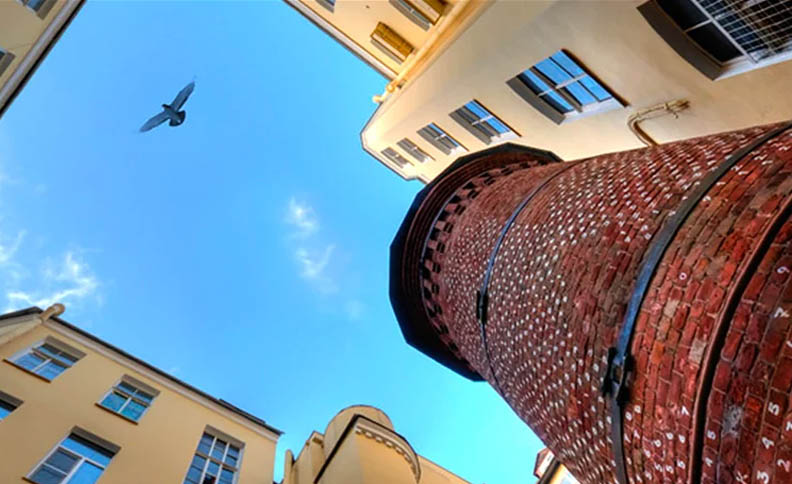We invite You to take a tour of Off-beat and non-standard places in St. Petersburg, where you can see Saint Petersburg from the inside, learn its secrets, legends and feel like one of the local residents.
Duration of the tour: 6-7 hours
STOP №1. Mosaic courtyard on Fontanka
The mosaic courtyard on Fontanka is part of an open-air Museum created by the artist Vladimir Lubenko and his students. Its visit is not included in the city tour programs, but we believe that it is worth looking into the amazing space and appreciate the bright objects decorated with mosaics. The usual gray courtyard of the house No. 2 on Tchaikovsky street began to transform in 1984, when a Small Academy of Arts with the emotional name “Volcano” opened nearby on the basis of the Russian State Museum. The founder and head of the Academy is Vladimir Lubenko, who has the title of Honored artist of Russia. After recruiting the first group of students, he invited them to take part in an unusual project and decorate the courtyard of the house where the Academy was located. The children agreed, and the work began. After a while, the courtyard turned into a fabulous mosaic space with original bas-reliefs and bright sculptures. The creative group led by Vladimir Lubenko decorated even the curbs and walls of the building with colored glass. The mosaic courtyard of the Academy of arts is divided into zones that can be viewed separately or as part of a single composition. Among the exhibits are figures of angels and people, animals and mythical creatures.

STOP №2. Annenkirche – abandoned Lutheran Church
The oldest Lutheran Church in St. Petersburg – a place of pilgrimage for fans of rock culture, modern art, as well as classical music. Among the first parishioners of the Church was the jeweler Carl Faberge. St. Anne’s Lutheran Church, or Annenkirche, was built in 1779. It also gave the name to the street where it is located: Kirochnaya, from the German “Kirche” – Church. The stone building was replaced by a wooden. By the beginning of the 20th century, it was a parish for Russified foreigners-Danes, Dutch, and Germans who had lived in Russia for generations and often did not know German. After the revolution, the Church became persecuted, and the Lutheran – especially. Before 1917, there were about a thousand Lutheran priests in Russia, and in 1939 there were none left – all were killed. By 1939, the Annenkirche had been redesigned as a movie theater. Inside, a staircase was built, an auditorium appeared, and a panel “the Uprising of Spartacus” was placed above the cross. The cinema has existed for five decades. In the 80’s, it was a Gosfilmofond cinema – there were pictures that were already being released in the Soviet Union. In the 90s, the country was swept by a wave of discos, which were held in the most unexpected places. Annenkirche was no exception. The Church became a popular place for discos for young people in the 90s. In 1998, the Church hosted its first rock concert. The movie theater was reformatted.
At the end of 2014, several artists came to Annenkirch. They offered to hold an exhibition of contemporary art called “Fear”. After that, various artists and aspiring artists began to apply to the Church. Now concerts, theater productions, performances and exhibitions attract from 5 to 10 thousand people every month. At the same time, services are held in the Church.


STOP №3. Courtyard on Kirochnaya street (Bak’s house)
The famous house of Y.Bak is known not only for its beautiful stained glass windows and suspended galleries, but also for the residents who collect the history of the house bit by bit and share their findings with the citizens. They not only publish news about their findings in the official community dedicated to the house of Bak, they also conduct tours of the house, telling about the history of the building and its former residents! The apartment house of Julian Bak was built in 1905 by the architect Boris Girshovich. The house was executed in the art Nouveau style with Rococo elements and has been preserved in its original decoration to the present day. The owner of the house, Julian Borisovich Bak, was a prominent public figure of his time, a railway engineer, and the founder and publisher of the democrats newspaper “Rech”. The most outstanding feature of the house is considered to be the unique suspended galleries. Thanks to them, you can go to the opposite part of the building without going down the courtyard. During the tour, you can visit the attic, which offers views of the surrounding area of the house.

STOP №4. The Court Of Spirits
Mystical and interesting places in St. Petersburg will never end. 15 minutes from Bak’s house is the courtyard, where dreams come true. When the creator of St. Petersburg, Peter the Great, planned the location of houses, he ordered that the buildings be built as a “solid facade”. He thought strategically: there is not enough land in the city, it will become more expensive, therefore, it must be used economically and effectively. As a result, the attraction of Northern Venice, in addition to palaces, temples and bridges, also became courtyards-wells. For more than a couple of centuries, many myths and legends have also been created about it. One of them says that the exact location of the “Court of Spirits” can not be reported – this is bad luck. According to another legend, anyone who came to the courtyard can make absolutely any wish if they look at the sky behind the iron bars, which will certainly come true. The exact address of the “Court of Spirits” is unknown. There are different versions of this account. One version, for example, points to a building with a Pharmacy of Pel’, located on the 7th line of Vasilievsky island. Once there an old Apothecary used to walk griffins at night, and sometimes you can see their reflection in the windows of the courtyard of the well. According to another version, as some claim, the “house of Spirits” is, of course, on the territory of Basil Island, but behind the house number 5 on the 4th line. By the way, at this address at the beginning of the last century lived the painter, philosopher and big explore of Indian and Tibitian Himalayas – Nicholas Roerich, one of the greatest mystics of that period in Russia and India.


STOP №5. Panoramic restaurant “I love you”
After such an emotionally intense program, anyone will want to relax a little and have chai with a snack. Just 10 minutes from the “Courtyard of Spirits” is a panoramic restaurant. The restaurant is called “I love you”, because the atmosphere of the place is filled with romance – from twisted hearts on plates, ending with a magical view of the sun-warmed roofs of St. Petersburg. The restaurant is located at an altitude of 60 meters above the ground!

STOP №6. Dr. Pel Pharmacy
The house of Dr. Pel is not only the oldest pharmacy in the Northern capital, but also a place surrounded by urban legends, rumors and theories. Here you will see the pharmacy itself, where we will talk about the history of pharmacy business. We will visit the bomb shelter of the Great Patriotic war. We will look into a secret laboratory, where we will learn about the alchemical theory, decipher the meaning of Masonic symbols, and also reveal the secrets of obtaining the philosopher’s stone. And at The Griffin tower in the courtyard you will hear ancient legends, draw a parallel between medicine and mysticism. It was said that in the tower was opened a portal to a parallel world, from where the griffins got to St. Petersburg – they was invisible, but local residence could heard them.



STOP №7. House with Rotunda porch
The three-story rotunda of the house on Gorokhovaya street is located in the corner of the building. You can get into it from the courtyard by opening a heavy metal door with an intercom. Inside, on the first floor, there are 6 massive columns placed in a circle. A spiral staircase runs up around them, radiating in two directions. The Concierge’s workplace is located on the side. On the second floor there are entrances to apartments, and the third one ends with a flat dome. Experts say that the appearance of the house is typical of buildings of the neoclassical era. The combination of a rectangle and a circle in the plan is a common feature of any building of that time, whether it is a Cathedral with a round dome and a rectangular nave or a Doric column. The unconventional form of the front door is also understandable – Central lobbies, unlike typical facades, often became the hallmark of houses of the 18th and 19th centuries. They were made functional and ornate to impress guests.
The house was built in 1780-90 years for a merchant Yakovlev. Since it belonged to a private person, there are no documents about the history of construction and reconstruction in the archives. It is not known exactly when the rotunda appeared in the corner of the building. Some citizens believe that it was built in 1856 by the architect Egor Winterhalter. Others believe that even before the construction of the house, six columns were placed in a circle on the site, around which workers erected the building. There is even a mystical version, according to which the rotunda was built for the rites of St. Petersburg masons, and the house itself belonged to one of the members of the Masonic lodge, count Andrey Zubov
Little is known about the condition and use of the building during the Soviet period. In 1980-90, the house on Gorokhovaya street was inhabited, and the rotunda became a favorite gathering place for fans of rock culture. Famous underground musicians gathered here. They were happy to arrange concerts and parties in a room with good acoustics. Residents of the house did not like the state of the front door, and they repeatedly tried to block the entrance to the rotunda to outsiders. Despite their best efforts, there were frequent parties. In 2006, one of the apartments in the building was purchased by Daniil lyubarov, who took over the duties of Chairman of the house Council. He offered the rest of the residents a creative solution to the problem of vandalism in the rotunda – to make repairs, paint over the inscriptions and set a symbolic entrance fee for tourists. Neighbors supported the proposal and jointly installed an iron door, installed wiring in the walls, hired Concierge services, and connected the security system.
In St. Petersburg, there is a popular myth that Devil visit the spiral staircase to the city at night. A person who comes to the stairs at midnight can meet him and ask for help. If the Devil responds, the request will be granted, but the petitioner will pay a heavy price for having dared to address him. The rotunda on Gorokhovaya street is open to the public according to the schedule: on weekdays from 18.00 to 22.00, on weekends-from 11.00 to 22.00. You can enter the front door for a donation. Fees are used to pay for Concierge services and issue information leaflets about the building.


STOP №8. Sevkabel port – loft art space
In the evening, you can enjoy an inspiring view of the Gulf of Finland in Sevkabel port! The Sevkabel Port cultural cluster is located on the territory of the cable factory of the same name. Founded in 1879, the Sevkabel Port plant is one of the oldest enterprises in the Northern capital. After modernizing production and reorganizing the company in 2014, it was decided to move the industrial workshops outside the city limits. As part of the renovation, some of the workshops were combined, allocating 20% of the space to create a cultural public space. Sevkabel Port is a place of attraction for creative people. It regularly hosts music and food festivals, concerts, fairs, exhibitions, meetings with writers, musicians, artists, bloggers, and other events.



Author: Maria Krasnopevets
Visit the Off-beat & Mystique St. Petersburg and many more that St Petersburg has to offer!
Contact us@ Russian InfoCenter to Book Classic Russia tour 5n/6d and more tour packages from India to Russia
Choose from flights ex Delhi, Mumbai & Calcutta
Fill the form below and we’ll get back to you right away!

